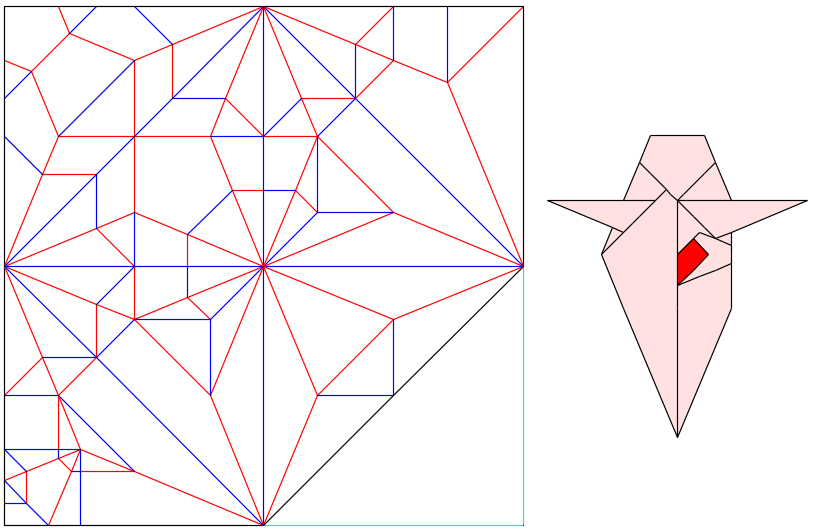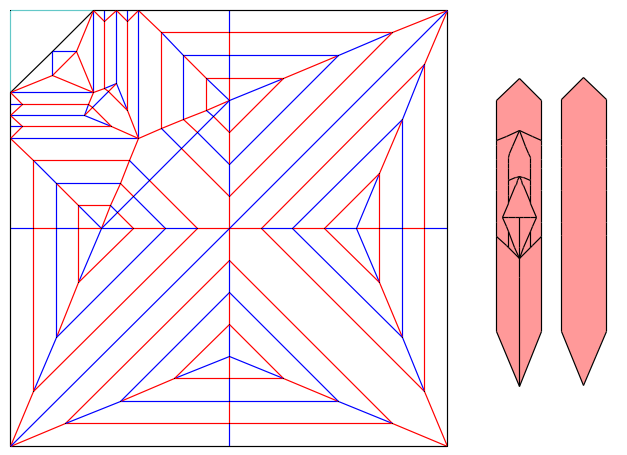Here we go with the prompt #21 until #27.
The requirement of 3 large flaps and 3 smaller flaps is ideal for bird base with one corner split. The challenge here is to make the curved structure on the sides. I have no other idea apart from doing the loose reverse fold.
Helicoprion is a prehistoric shark with teeth on lower jaw that looks like circular saw. I don't have experience on folding teeth apart from Takagi's mosasaurus which used a long flap that gets pleated. To follow that idea, I reserved the entire 1/4 corner for lower jaw. Naturally the upper jaw can be put in the middle to make a bird-base like structure:
I feel that Pokemon is a difficult subject. My goal is to make something that immediately evoke "hey this is <insert Pokemon name>" and came upon the idea to make Voltorb.
I wanted to make a chunky ape-like creature with big hands and small legs. This reminds me of my Tank. The main structure is reused but simplified since the legs are supposed to be short. The fish base for body is swapped with bird base to provide shorter hands and longer head flap. This head flap can be filled with details like facial structure.
The word "crawl" made me imagine a creature dragging its body with its hands. I remembered the suitable creature from encyclopedia I read as a kid. This burrowing lizard really has only forelimbs and long worm-like body.
#21 Ornament: Fleur de Lis
The requirement of 3 large flaps and 3 smaller flaps is ideal for bird base with one corner split. The challenge here is to make the curved structure on the sides. I have no other idea apart from doing the loose reverse fold.
#22 Teeth: Helicoprion
Helicoprion is a prehistoric shark with teeth on lower jaw that looks like circular saw. I don't have experience on folding teeth apart from Takagi's mosasaurus which used a long flap that gets pleated. To follow that idea, I reserved the entire 1/4 corner for lower jaw. Naturally the upper jaw can be put in the middle to make a bird-base like structure:
The remaining corners somehow should form body, tail, and other fins. It doesn't matter which corner should be used for the tail, the body length will the same since any remaining corners will yield the largest possible circle. I picked the lower left and now it became like a full blown bird base.
I made a bird base and just start to do free folding. Through random experimentation I used the remaining corner for fins. They are all made from point splitting.
There was one problem though, the teeth was thick. After all it was made from a flap with thickness of 2 layers of paper. The solution is to simply release the layer underneath. The final CP is shown above.
#23 Dark: Voodoo Doll
Dark magic or black magic, doesn't matter. I just want to make a humanoid doll with heart in it. I tried to use fish base to make the heart through free folding and got this arrangement. It's done by squashing the smaller flap, then valley fold the raw corner. What's left is just hide the top portion behind.
To fill in the body, I put a massive diagonal graft and free-styled. The structure actually looks similar to my poison dart frog.
#24 Pokemon: Voltorb
I feel that Pokemon is a difficult subject. My goal is to make something that immediately evoke "hey this is <insert Pokemon name>" and came upon the idea to make Voltorb.
The first thing is folding the bottom edge up and provide the lower half color change. The eyes are free folded. A simple squash did the job well.
There's no clear reference for top half of this model. Just eyeball it to make this ball with eyes.
#25 Snow: Abominable Snowman
I wanted to make a chunky ape-like creature with big hands and small legs. This reminds me of my Tank. The main structure is reused but simplified since the legs are supposed to be short. The fish base for body is swapped with bird base to provide shorter hands and longer head flap. This head flap can be filled with details like facial structure.
On that day, I folded "Adult Syn" by Syn and amazed by how a single flap get turned into face. I followed the same approach and produced the ape-like face as shown above.
 |
| Adult Syn, diagram in Orifancy 2. |
#26 Crawl: Mole Lizard
The word "crawl" made me imagine a creature dragging its body with its hands. I remembered the suitable creature from encyclopedia I read as a kid. This burrowing lizard really has only forelimbs and long worm-like body.
To minimize paper wastage, usually long model like snake is made like knot. The knot is place where all the flaps will come out. Hiding the flap origin under this "knot" made illusion that the model is long.
In this model I used a bird base. All 3 long flaps are used for body. The middle flap became head, and the remaining long flap is split for the legs. This structure is similar with fleur de lis I made before, just with some toes.
#27 Wild: Wildebeest
What makes this creature different from other cattle or antelope like creature is its neck. There are fur there and makes it look like layer. To make it so I just need to make a 4 legged creature with ears and horns, but with long neck. The neck is then pleated to imitate the fur. I used the classic silver rectangle structure to achieve this.
The downside of this structure is the center of mass. There are more paper devoted to the neck and head, so that part is heavier. Tilting the foreleg a bit to the front is necessary to make this model stand.
Remarks
I actually missed the prompt #22 to #24 and made it afterwards. I couldn't fold at that time because my hand kept tingling whenever I fold due to poor blood circulation. After all I spent the entire day sitting with hands on table. A week of exercising cured me from this problem. So be sure to exercise to keep your heart healthy!
Most of the challenges in this period was made using bird base. I felt like spamming it, but thinking again, it is not necessarily bad. If a simple structure works then no need to think of complicated one.
Thanks for reading. Also check the previous challenge.



















Comments
Post a Comment